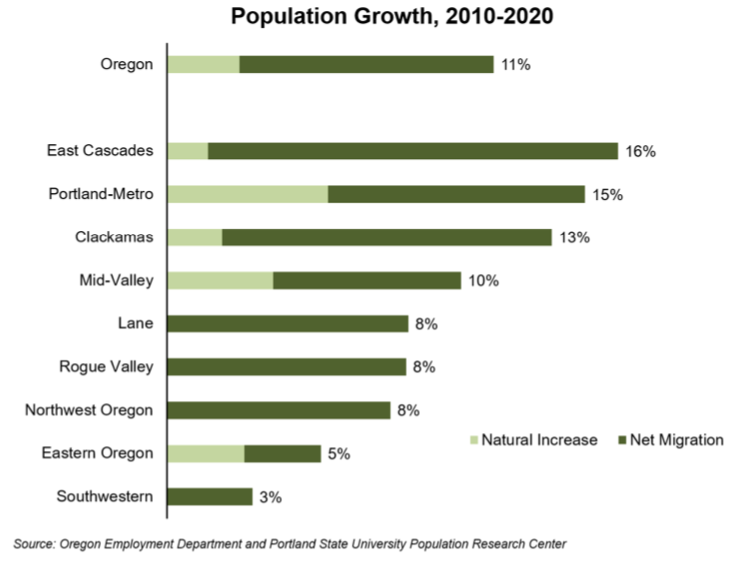Lane County Depends on Migration for Population Growth
The newest estimates from Portland State University’s Population Research Center confirm what Oregonians have known for some time: Oregon continued its long population growth streak in the last decade.

While population growth can bring negative impacts, like greater competition when purchasing a home or increased traffic congestion, sustained population growth has been an asset for Oregon’s economy for decades. Attracting workers from all over the U.S., as we do, increases the size and skill of Oregon’s workforce. Adding to population adds to demand for local goods and services, increasing the number of jobs.
The growth can be felt all across the state. Each region of Oregon has added population since the last Census in 2010. However, looking at Oregon’s nine workforce areas tells an interesting story about the reasons and rate of growth, which has impacts on the local economy.
There are two ways population changes. Net migration is the number of people moving here minus the number moving away. Natural increase or decrease is the number of people born minus the number of people who die. All areas of Oregon had positive net migration from 2010 to 2020, meaning that more people moved to a region than away, although at different rates.
When it comes to “natural change” not every area saw growth. In Lane County, the Rogue Valley, and the Coast, there was a natural decrease in population in the last decade, meaning that more people died than were born from 2010 to 2020. Southwestern Oregon and the Rogue Valley each had substantial natural decreases (a decline of around 3% of their 2010 population together) while Lane County and Northwest Oregon had only a very small decline.
The chart below shows the growth rate of each area and the contribution to growth of the two population factors. Oregon grew at 11%, with about 80% of the change coming from net migration.
Central Oregon and specifically Deschutes County, which has been a migration hub for many years, led the state’s growth on a percentage basis. Portland also grew faster than average.
The natural increase in the state’s population was driven by the Portland Metro, the mid-Willamette Valley, and Eastern Oregon. The population in those areas of the state is younger and more diverse, factors that contribute to a higher rate of natural population growth.
Seeing natural decrease over the decade in Lane County came as a surprise to many, but the trend has been coming a long time and is unlikely to reverse in the near future. As our population ages, and families have fewer children later in life, structural factors are bringing down rates of natural population growth in many areas of the U.S.
Natural decrease in population doesn’t mean the sky is falling in Lane, the Rogue Valley or the Coast, but it’s important to understand the factors underlying the trends. If migration patterns (which are more variable than natural change) shift rapidly, it could have a significant impact on the structure of the workforce. For the time being, Oregon doesn’t look any less likely to attract newcomers than in decades past.


Advertisement